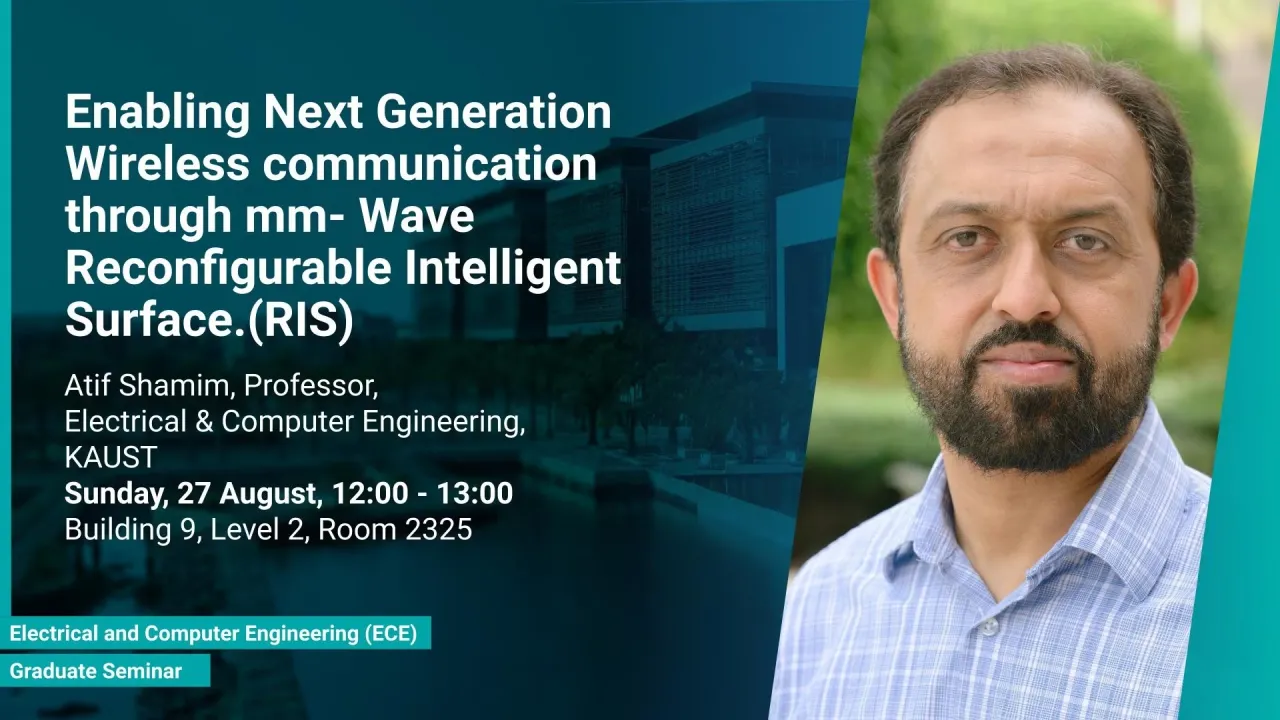
Enabling Next Generation Wireless Communication through mm-Wave Reconfigurable Intelligent Surface (RIS)
The mm-wave 5G and beyond communication systems significantly improve the data rate, user capacity, and latency, however, the electromagnetic (EM) wave propagation suffers from high atmospheric attenuation as compared to the sub-6 GHz bands.
Overview
Abstract
The mm-wave 5G and beyond communication systems significantly improve the data rate, user capacity, and latency, however, the electromagnetic (EM) wave propagation suffers from high atmospheric attenuation as compared to the sub-6 GHz bands. Therefore, the quality of wireless communication gets severely affected in an environment where multiple obstacles, such as buildings and trees, are present, and thus, communication coverage is typically limited to line of sight (LOS). In order to maintain a high-quality communication link, reconfigurable intelligent surfaces (RIS) can help by providing a secondary LOS. RIS is a specially designed periodic structure that can be reconfigured to reflect the EM signal in the desired direction. With the help of RIS, the wireless environment can become controllable and programmable, and can thus bring unprecedented new opportunities for mm-Wave wireless communication systems. Despite the growing interest in RIS, and a lot of theoretical work reported by the communication society, there is still a dearth of published works demonstrating practical implementations and experimental results. This is particularly true for experimental demonstrations of wideband RIS covering both n257 and n258 mm-wave bands for 5G communication. In this talk, first, fundamental concepts related to RIS are introduced, and then EM design, prototyping steps and complete experimental characterization of a wideband RIS is shown that covers the mmWave 5G band (22.5 – 29.5 GHz (~27% bandwidth)), with a beam scanning capability of 50°. With low cost and volume manufacturing in mind, another wideband mm-Wave RIS design is presented which is fully screen-printed. This design uses novel printed switches based on Vanadium-di-oxide phase change material. Finally, an RIS design realized through an optically transparent metallic ink is shown.
Brief Biography
received his MS and PhD degrees in electrical engineering from Carleton University, Canada in 2004 and 2009 respectively. He was an NSERC Alexander Graham Bell Graduate scholar at Carleton University from 2007 till 2009 and an NSERC postdoctoral Fellow in 2009-2010 at Royal Military College Canada and KAUST. In August 2010, he joined the Electrical and Computer Engineering Program at KAUST, where he is currently a Full Professor and Principal Investigator of IMPACT Lab. He was an invited researcher at the VTT Micro-Modules Research Center (Oulu, Finland) in 2006. His research work has won best paper awards in IEEE ICMAC 2021, IEEE IMS 2016, IEEE MECAP 2016, IEEE EuWiT 2008, first prize in IEEE IMS 2019 3MT competition and IEEE AP-S Design Competition 2022, finalist/honorable mention prizes in IEEE AP-S Design Competition 2020, IEEE IMS 2017 (3MT competition), IEEE IMS 2014, IEEE APS 2005 and R. W. P. King prize for journal papers in IEEE TAP 2017 and 2020. He has been selected as the Distinguished Lecturer for IEEE AP-S (2022-2024). He has won the Kings Prize for the best innovation of the year (2018) for his work on sensors for the oil industry. He was given the Ottawa Centre of Research Innovation (OCRI) Researcher of the Year Award in 2008 in Canada. His work on Wireless Dosimeter won the ITAC SMC Award at Canadian Microelectronics Corporation TEXPO in 2007. Prof. Shamim also won numerous business-related awards, including 1st prize in Canada’s national business plan competition and was awarded OCRI Entrepreneur of the year award in 2010. He is an author/co-author of 300 international publications, an inventor on 40 patents and has given 100 invited talks at various international forums. His research interests are in innovative antenna designs and their integration strategies with circuits and sensors for flexible and wearable wireless sensing systems through a combination of CMOS and additive manufacturing technologies. He has served on the editorial board of IEEE Transactions on Antennas and Propagation (2013-2019), and as a Guest Editor for IEEE AWPL Special issue (2019), and is currently serving as an Associate Editor for IEEE Journal of Electromagnetics, RF and Microwaves in Medicine and Biology. He serves on numerous IEEE committees such IEEE Technical committees on Antenna Measurements (AP-S), Microwave Controls (MTT-S 13), and Additive Manufacturing (CRFID).